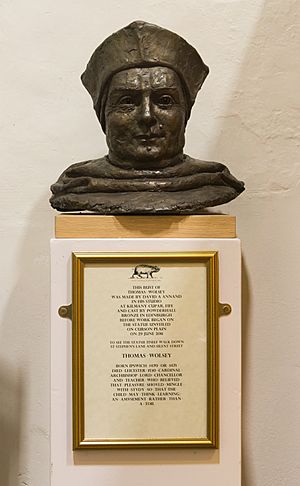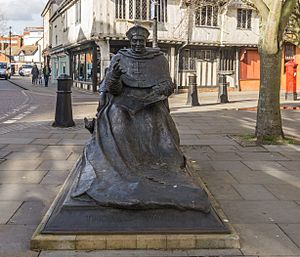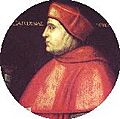Thomas Wolsey facts for kids
Quick facts for kids
His Eminence
The Most Reverend and Right Honourable Thomas Wolsey
|
|
|---|---|
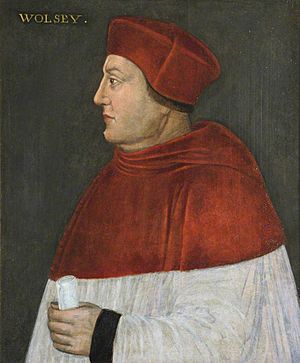
|
|
| Lord High Chancellor of England | |
| In office 1515–1529 |
|
| Preceded by | William Warham |
| Succeeded by | Sir Thomas More |
| Personal details | |
| Born | c. March 1473 Ipswich, Suffolk, England |
| Died | 29 November 1530 (aged 57) Leicester, Leicestershire, England |
| Children | Thomas and Dorothy |
| Parents | Robert Wolsey (father) and Joan Daundy (mother) |
| Education | Magdalen College, Oxford |
| Signature |  |
Thomas Wolsey (born around March 1473 – died 29 November 1530) was an important English leader and a Catholic bishop. When Henry VIII became King of England in 1509, Wolsey quickly became a very powerful figure. He was in charge of almost everything the government did.
In 1515, Pope Leo X made him a cardinal. This meant he was more important than all other church leaders in England. Wolsey's highest job in government was Lord Chancellor. This made him the king's main advisor. He had so much power that people sometimes called him the "other king."
However, Wolsey eventually lost the king's trust. This happened when he could not help King Henry end his marriage to Catherine of Aragon. Wolsey lost his government jobs and was accused of treason. He died from natural causes before he could be put on trial.
Contents
Thomas Wolsey's Early Life
Thomas Wolsey was born around 1473 in Ipswich, England. His father was Robert Wolsey and his mother was Joan Daundy. Thomas went to Ipswich School and then to Magdalen College, Oxford. There, he studied to become a priest.
On 10 March 1498, he became a priest in Marlborough. He stayed at Oxford for a while, first as a teacher and then as a dean. From 1500 to 1509, Wolsey worked as a priest at St Mary's church in Limington.
Wolsey came from a simple family. But he rose to power very quickly. This shows how smart, hardworking, and good he was at managing things. He also had a very good relationship with King Henry VII.
Wolsey's Career and Power
Wolsey's rise to power happened when Henry VIII became king in April 1509. He quickly became the king's most trusted advisor. For 14 years, Wolsey was Lord Chancellor. He had more power than almost anyone else in English history. Because of this, many nobles did not like him.
Wolsey also gained more power in the church. Pope Leo X made him a cardinal in 1515. With his church roles, he became very rich and owned many lands.
The king strongly supported Wolsey. The Pope also gave Wolsey special powers over the church. This meant Wolsey was in charge of many important areas. These included government, laws, the church, and how England dealt with other countries. He was very energetic and achieved a lot.
Wolsey became very wealthy. He also helped support arts, education, and learning. He tried to make many changes, and some of them worked. These changes were in areas like money, taxes, schools, and justice. From the king's point of view, Wolsey's biggest failure was not getting him a divorce. Henry wanted a new wife to have a son who would be the clear heir to the throne.
Historians agree that Wolsey was a very ambitious man. In the end, the king stopped supporting him. Wolsey was accused of treason, but he died of natural causes before he could be executed.
Changes to Taxation
Wolsey made important changes to the tax system. Before, everyone paid a fixed tax, even if they earned very little. Wolsey introduced a new income tax. This meant poorer people paid much less. Richer people paid more, which was a fairer system.
This new tax helped Wolsey raise a lot of money for the king's foreign trips. He collected over £300,000. He also got money in other ways. For example, he asked for "benevolences," which were like forced gifts from rich people. He also made nobles give loans to the king. These loans brought in £200,000 in 1522.
However, Wolsey's tax policies became unpopular. His forced loans and gifts led to a big protest called the Amicable Grant in 1525.
Changes to Justice
As a legal leader, Wolsey improved the equity court system. In these courts, a judge decided cases based on what was "fair." This was different from the Common Law courts. Wolsey brought back the Star Chamber and the Court of Chancery.
These courts focused on simple, cheap cases. They promised fair justice for everyone. Wolsey also created the Court of Requests for poor people. They did not have to pay any fees there. Wolsey's legal changes were very popular. So many people came that extra courts were needed.
Many powerful men who thought they were above the law were found guilty. For example, in 1515, the Earl of Northumberland was sent to prison. In 1516, Lord Abergavenny was accused of breaking a law about keeping too many followers.
Wolsey used the Star Chamber to control prices. In 1518, he set a "Just Price" policy. This tried to control the price of meat in London and other big cities. People who charged too much were punished. After a bad harvest in 1527, Wolsey bought extra grain. He then sold it cheaply to people who needed it. This helped prevent unrest and became a common practice after bad harvests.
Church Reforms and Education
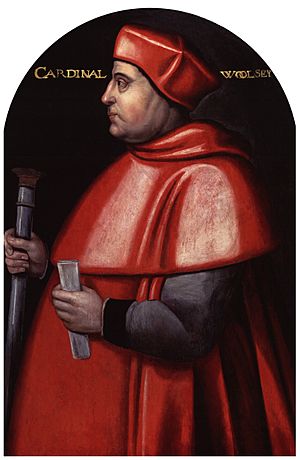
In 1524 and 1527, Wolsey used his power as the Pope's representative. He closed 30 monasteries that were not working well. Some of these were in Ipswich and Oxford. He used the money from these monasteries to start new schools.
He founded a grammar school in Ipswich, which is now The King's School, Ipswich. He also founded Cardinal College in Oxford. After Wolsey lost power, the king renamed it King Henry VIII's College. Today, it is known as Christ Church. In 1528, Wolsey also started to limit the "benefit of clergy." This was a rule that allowed church members to be tried in church courts, which were often more lenient.
Art and Building Projects
From 1515, when he became a cardinal, until his death, Wolsey used art and buildings to show his power. He started building projects that were huge. No other English church leader or Lord Chancellor had built so much. Only a few kings built more. He brought Italian Renaissance ideas and classical styles into English architecture.
Wolsey's projects included grand additions to York Palace in London. This was the home of the Archbishop of York. He also managed the amazing temporary buildings at the Field of Cloth of Gold. He also improved Hampton Court Palace, which he later gave to the king. Wolsey used buildings to show power. His use of Italian styles set a trend that Henry VIII and others continued.
Wolsey also oversaw tombs for Henry VIII's parents at Westminster Abbey. He also made plans for Henry VIII's own tomb and one for himself. If these had been finished, they would have been some of the largest and grandest tombs in Europe. The college Wolsey founded in Oxford, Christ Church, is still the largest and grandest college there.
Wolsey's Downfall and Death
Even though Wolsey had many enemies, King Henry VIII trusted him for a long time. This changed when Henry wanted to end his marriage to Catherine of Aragon. He wanted to marry Anne Boleyn. Wolsey's failure to get the king's marriage ended directly led to his downfall.
It was rumored that Anne Boleyn and her supporters told Henry that Wolsey was purposely slowing things down. Because of this, Wolsey was arrested in 1529. The Pope decided that the final decision about the marriage should be made in Rome, not England.
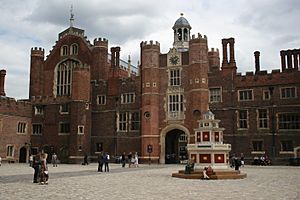
In 1529, Wolsey lost his government job and all his property. This included his beautiful home, Hampton Court. King Henry took Hampton Court to be his own main home in London. Wolsey was allowed to remain Archbishop of York. He traveled to Yorkshire for the first time in his career.
But at Cawood in North Yorkshire, he was accused of treason. He was ordered to go to London by Henry Percy, 6th Earl of Northumberland. Wolsey was very upset. He started his journey to London with his chaplain, Edmund Bonner. He became very sick on the way.
He died in Leicester on 29 November 1530, when he was about 57 years old. Just before he died, he is said to have spoken these words:
I see the matter against me how it is framed. But if I had served God as diligently as I have done the King, he would not have given me over in my grey hairs.
Wolsey had planned a grand tomb for himself at Windsor. But he was buried in Leicester Abbey (now Abbey Park) without a monument. King Henry VIII thought about using Wolsey's impressive black tomb for himself. However, Lord Nelson is now buried in it, in St. Paul's Cathedral. Henry often gets credit for art projects that Wolsey actually started.
Memorials to Wolsey
Before Wolsey lost power, he wanted to make his hometown of Ipswich a center for learning. He built a large college there. For two years, from 1528 to 1530, this college was the parent of Ipswich School. Today, Ipswich School is still thriving on a different site.
All that remains of Wolsey's building is an old gate by the water. You can still see it on College Street. In 1930, Wolsey was remembered in Ipswich with a big play. He is still remembered in Ipswich today. In October 2009, people started a project to build a statue of him.
On 29 June 2011, a bronze statue of Cardinal Wolsey was unveiled. It is larger than life-size and shows him seated, teaching from a book. A cat is by his side. The statue is near where Wolsey's home used to be on St Nicholas Street in Ipswich. The sculptor was David Annand.
A statue of Wolsey also stands in Leicester's Abbey Park. This is close to where he was buried. The Wolsey hosiery company donated it. This company was a major employer in the city and was also named after the cardinal.
The Wolsey Place shopping center and Woking F.C.'s nickname, "The Cardinals," remember Wolsey. This is because Wolsey was visiting Henry VIII at Woking Palace when he heard he had been made a cardinal.
Other Facts
Cardinal Wolsey's bust was used in the 1980s on London's buses. It was above the London Transport roundel in west and south-west London. It was the symbol for the Cardinal bus district, named after him and his home at Hampton Court.
Carlos Logario, a Spanish doctor, worked as Thomas Wolsey's doctor in England.
Arms
Images for kids
-
"Cardinal Woolsey" (an archaic spelling) by an unknown artist c.1520. Detail from an oil on panel in the National Portrait Gallery
-
Queen Catherine of Aragon, by an unknown artist
See also
 In Spanish: Thomas Wolsey para niños
In Spanish: Thomas Wolsey para niños



